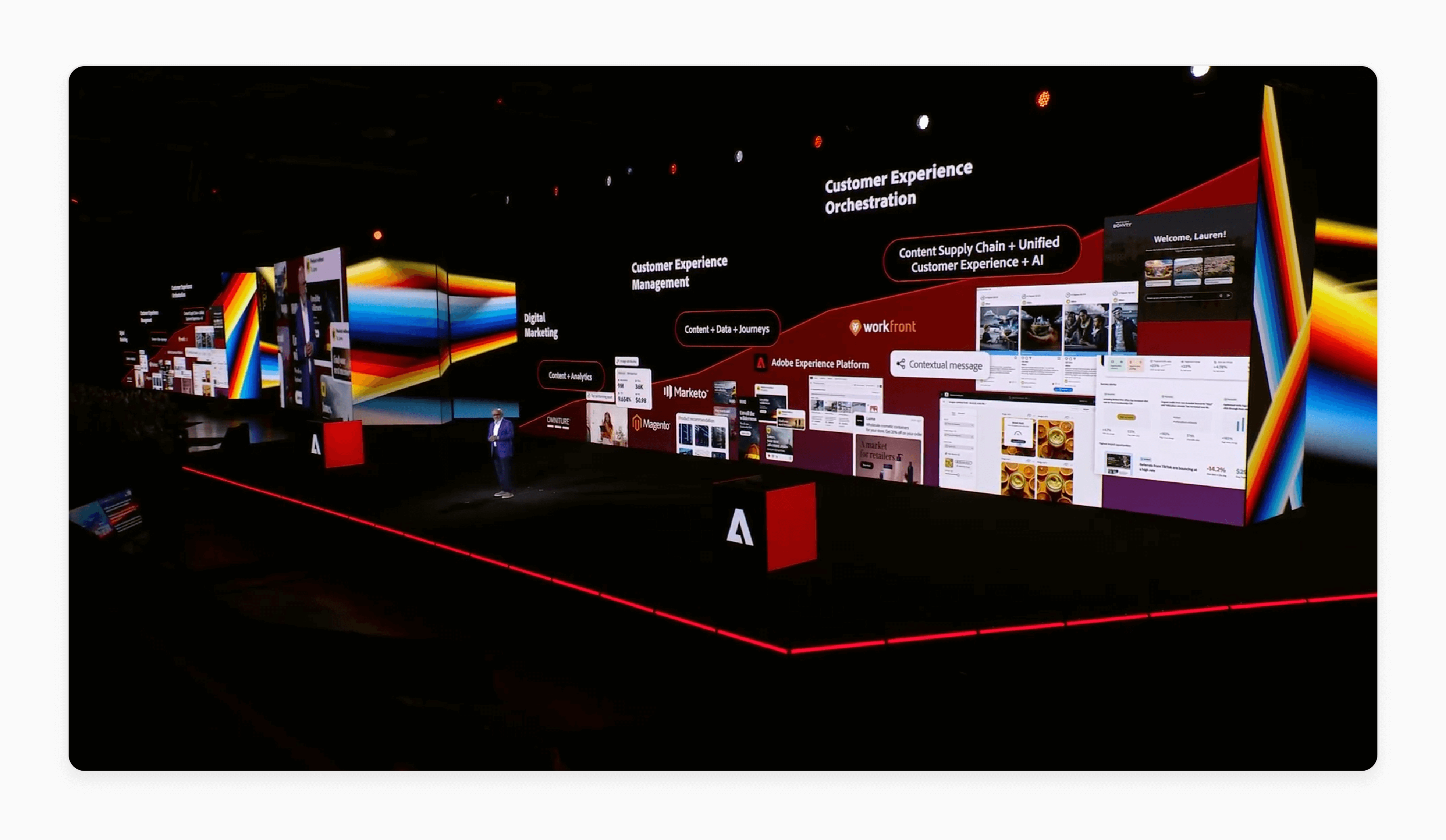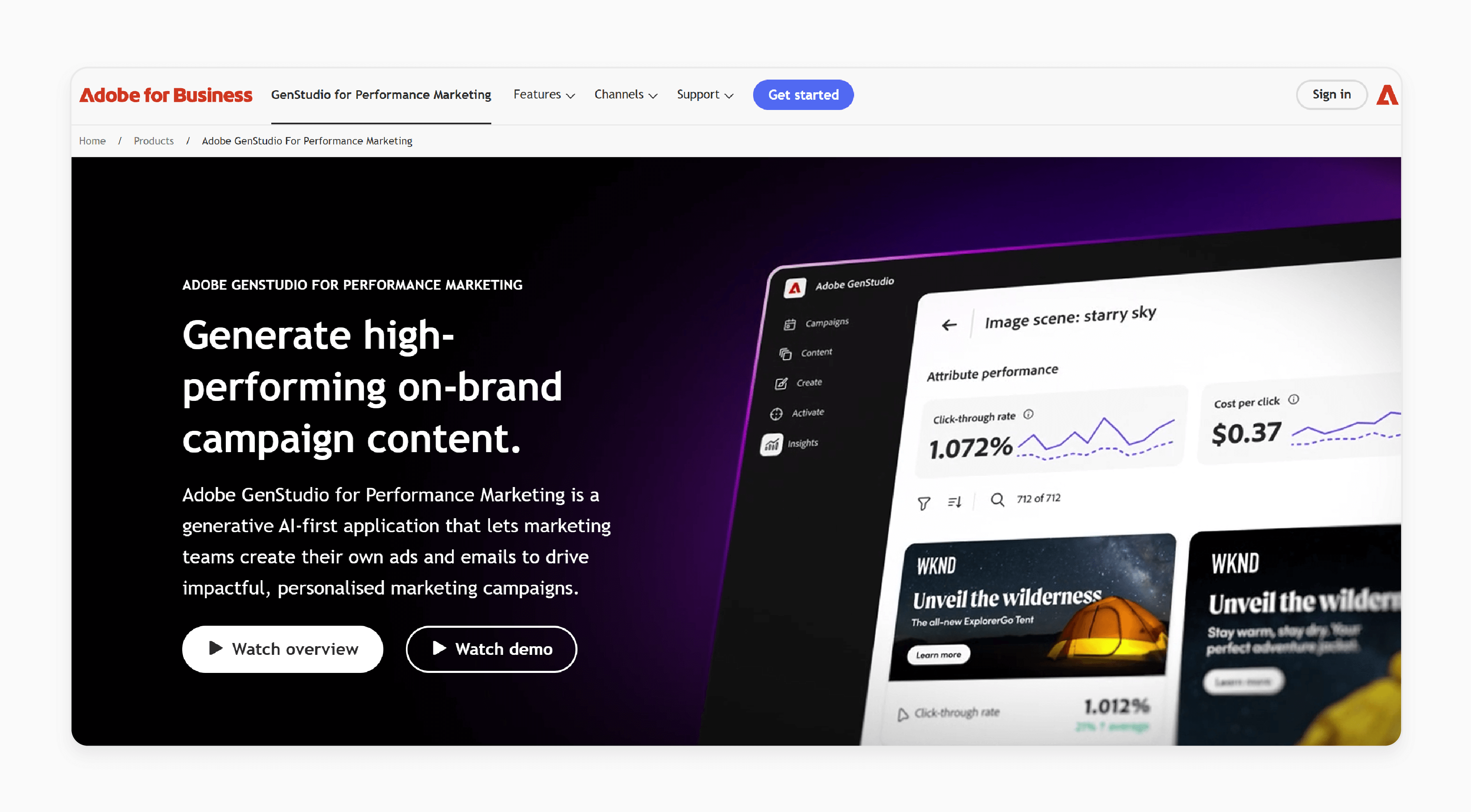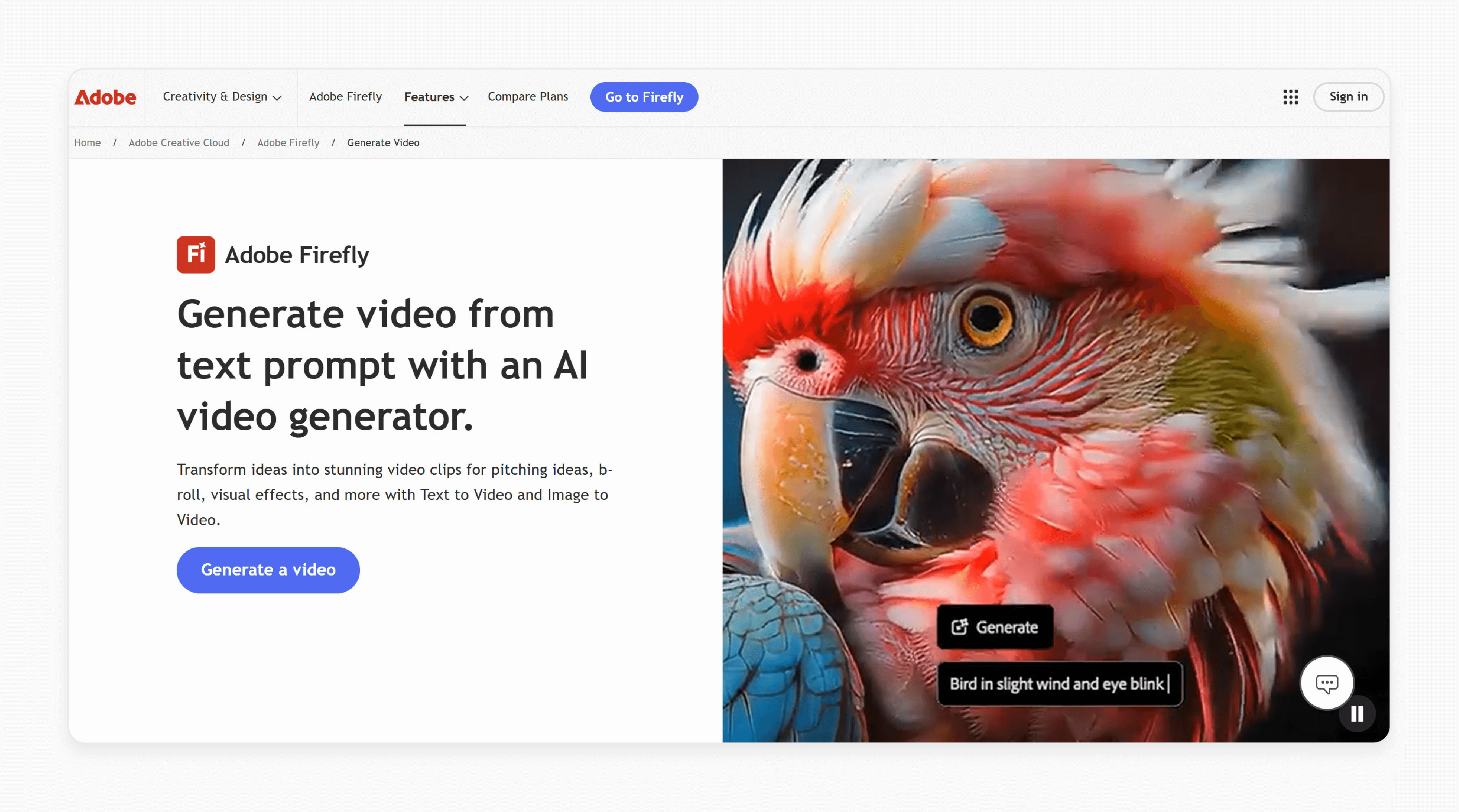
What are The AI-Powered CXO Innovations Featured at Adobe Summit 2025?
Interested in staying current on digital marketing trends & future innovations? Adobe Summit 2025 showcases how AI reshapes digital marketing via AI agents. These innovations enable businesses to enhance customer experiences & remain competitive.
This article will cover the top innovations from Adobe Summit 2025.
Key Takeaways
- Adobe shifts from CXM to CXO for dynamic, real-time customer experiences.
- New AI Platform introduces specialized agents for marketing automation.
- GenStudio Foundation connects content creation, management, and delivery.
- Implementation strategies customized to meet the unique needs of enterprises and industries.
- Real-world applications show significant ROI in personalization and workflow optimization.
- Adobe's shift to Customer Experience Orchestration transforms marketing.
- Real-world applications of GenStudio and Firefly for smarter content workflows and boosted CX.
-
Adobe's Vision for Customer Experience Orchestration (CXO) in 2025
-
How Does the Adobe AI Platform Transform Marketing with Agentic AI?
-
How Can Small and Medium Businesses Gain Value from Adobe Summit?
-
Adobe Summit 2025: Implementation Strategies for Different Industries
-
Real-World Applications and Use Cases of GenStudio and Firefly
What is Adobe Summit 2025?
Adobe Summit is an event for discovering customer experience (CX) technologies. It brings together industry leaders, innovators, and businesses of all sizes.
Held from March 17–20 in Las Vegas & online, the summit highlighted a major shift in how companies approach CX. It focused on enabling a more dynamic way for brands to connect with customers.
This year, artificial intelligence (AI) emerged as the central theme of the event. It marked Adobe’s move from CX Management to a more dynamic CX Orchestration approach. Unlike CXM, which manages isolated interactions, CXO employs a more dynamic & real-time approach. It allows brands to deliver personalized, flexible experiences across the entire customer journey.
Adobe's Vision for Customer Experience Orchestration (CXO) in 2025

1. A Big Shift From CXM to CXO
Earlier, CXOs used static, rule-based personalization. Now, they use AI to deliver real-time, adaptive experiences. AI reads customer behavior and adjusts the journey across all touchpoints. With CXO, brands don’t rely on pre-set paths. The experience evolves based on live customer signals and context. It’s smarter, faster, and more personal.
2. Advanced Business Benefits
Brands that adopt CXO see major benefits, such as:
- Personalization at scale becomes possible. AI handles the complex task of customizing content for millions of users.
- Real-time decisions help brands react to customer behavior in milliseconds. Adobe's AI analyzes the data and suggests the next best move immediately.
- The CXO ensures a consistent brand experience across all channels. Examples include "web", "mobile", "social", and "in-store".
3. Creativity and Marketing Integration
Adobe’s most innovative change is connecting creative teams with marketing teams. These departments worked in silos. This process led to delays and inconsistent customer experiences.
Adobe’s tools now enable creative content to integrate into marketing platforms. Assets get tagged, versioned, and optimized for each channel. Creative teams receive feedback on their performance. Marketers can provide input earlier in the content process. It results in a smoother system that preserves creativity while enhancing results.
How Does the Adobe AI Platform Transform Marketing with Agentic AI?
1. Adobe Experience Platform Agent Orchestrator

The Experience Platform Agent Orchestrator is at the core of Adobe’s AI strategy. This system manages many specialized AI agents across customer experience and marketing workflows. An AI agent should handle tasks based on customer context. It must also integrate insights from various AI models. Thus, customers would get a smooth, personalized experience that feels natural to them.
2. Purpose-Built AI Agents
At Adobe Summit 2025, Adobe introduced ten new AI agents, each designed for a unique role in marketing. Here are a few examples:
- Site Optimization Agent: Finds and fixes website issues. It also helps run tests to improve conversions without needing any manual work.
- Audience Agent: Analyzes customer data to uncover new segments and predict behavior. It helps brands target the right people at the right time.
- Content Agent: Reviews your content and suggests ways to improve it. It can also create new versions customized to different customer groups.
- Journey Agent: Maps out the best paths for customers across all touchpoints. It also adjusts in real-time based on what’s working.
- Commerce Agent: Recommends products and adjusts pricing based on behavior and demand. Brands using it report a boost in average order value.
3. Multi-Agent Collaboration
Adobe’s AI tools shine brightest when the agents work together. Each AI agent has a specific task that addresses complex marketing objectives.
The system works in the following way:
- The Audience Agent identifies the most effective customer segments.
- The Content Agent creates customized messages for those segments.
- The Journey Agent decides when and where to send those messages.
The Agent Orchestrator coordinates this. It helps prevent overlap and ensure a consistent experience across channels.
Brands using this system see campaigns launch faster and report higher engagement.
4. Brand Concierge
Brand Concierge is Adobe’s new AI-powered assistant that brings conversations to life. It’s more than a chatbot. It helps users understand products and customer needs and provides smart recommendations.
The system can:
- Chat with customers using product data and customer history.
- Understand follow-up questions and remember the context of conversations.
- Help guide users from browsing to buying, all within a single experience.
How Can Small and Medium Businesses Gain Value from Adobe Summit?
| Adobe Summit Keyword/Theme | Unique SMB Benefit | Next-Gen Tools Driving SMB Success |
|---|---|---|
| Adobe GenStudio for SMBs | Helps SMBs compete with larger brands by creating brand-aligned content at enterprise speed. | GenStudio Foundation |
| Free Online Sessions | SMBs get direct access to expert playbooks and insider strategies. | Adobe Summit On-Demand Sessions & Learning Paths |
| Cost-Effective Implementation | Sessions break down how to deploy Adobe tools without overspending. | Modular API-driven Adobe Experience Cloud |
| Live Search in Adobe Commerce | SMBs can enhance their online store’s search results without a dev team or custom code. | Adobe Commerce Live Search |
| Success Metrics for Lean Teams | Learn how to track sessions and measure ROI and performance with limited resources. | Adobe Analytics AI |
| Sneaks: Project Panorama & Slide Wow | Early access to tools that map digital ecosystems and auto-generate slides from prompts. | Project Panorama and Project Slide Wow |
| AI-Powered Content Creation | AI tools let SMBs create, translate, and remix content at scale with no agency fees. | Firefly Services APIs and Firefly Creative Production |
| On-Demand Learning Paths | SMBs receive integrated tutorials and documentation, enabling them to set up new features. | Adobe Experience Cloud Learning Hub |
| Human-AI Partnership | SMBs learn how to blend automation with creativity. | Adobe Sensei AI Platform |
| Ethical AI & Content Credentials | SMBs gain built-in digital content credentials that reveal asset lineage, safeguarding brand & reputation. | Content Authenticity Initiative |
| API-Driven, Modular Solutions | SMBs can pick features, integrating Adobe tools into their stack as they grow. | Modular Adobe Experience Cloud APIs |
| Community & Networking | SMBs connect with peers, experts, and Adobe insiders for real answers. | Adobe Summit Discord Community & Adobe Experience Cloud |
Adobe Summit 2025: New Content Supply Chain Innovations
1. GenStudio Foundation Boosts Content Workflow

Adobe GenStudio Foundation represents a significant advancement in content creation. It brings together every part of the content process. For example, it encompasses "planning", "creation", "management", and "publishing" within a connected system.
Key benefits include:
- Speeds up content production by removing handoffs between teams.
- Integrates with Creative Cloud, Experience Manager, and more.
- Includes shared planning tools, asset libraries with version control, and faster approval workflows.
With GenStudio, teams create more content faster and stay aligned on goals & audiences.
2. Firefly AI Powers Smarter Video Creation

Adobe Firefly AI for Video simplifies creating & adapting video content for global audiences.
Key features include:
- Translate videos with automatic lip-syncing in various languages.
- Reframe videos for different screen sizes and platforms.
- Use scene extension to widen shots without losing quality.
These tools save time and help brands deliver better videos across more markets.
3. New Content Analytics

Adobe Content Analytics helps marketers understand which parts of their content are effective.
Key advantages include:
- Use AI to tag elements such as tone, style, and featured products.
- Track how those elements perform across different audiences.
- Show clear visuals of what’s working and what isn’t.
Instead of clicks & views, brands identify which visuals, words, or formats drive results.
How to Access Adobe Summit 2025 Resources?
| Adobe Summit 2025 Resource Type | How to Access Adobe Summit 2025 Resources | What You Get with Each Resource |
|---|---|---|
| On-Demand Sessions | Register for Adobe Summit Online (March 18–19, 2025). Visit the official Summit site and sign up for free. | Record live keynotes, strategy sessions, sneak peeks, and select breakout content. Most in-person sessions are available for replay in April. |
| Community Engagement Opportunities | Join the Adobe Summit Community Pavilion (in-person). You can also connect online via the Summit Discord and forums. | Network with peers, meet Adobe experts, join discussions, & access exclusive partner content & practices. |
| Learning Pathways for All Skill Levels | Use the Adobe Summit attendee dashboard to explore sessions by track and skill level. | Curate learning tracks, hands-on labs, and tutorials for beginners and advanced users. |
| Official Resources & Documentation | Access the official Adobe Summit site for documentation, FAQs, and event updates. | Document session catalogs, speaker bios, products, and detailed guides for implementing new tools. |
| Mobile App for In-Person Attendees | Download the Adobe Summit mobile app from your attendee dashboard after registering. | Build your schedule, connect with other attendees, get real-time updates, & navigate the event. |
| Networking & Community Events | Attend in-person mixers, receptions, and the Summit Bash via virtual networking. | Build connections and share insights with Adobe partners, sponsors, and industry leaders. |
Adobe Summit 2025: Implementation Strategies for Different Industries
1. Enterprise Considerations
Large companies face hurdles when adopting Adobe’s new CXO and AI tools. They must integrate Adobe with older systems (e.g., "CRM", "ERP", and internal content platforms). Customer data is often siloed, making it hard to unify. Adobe’s Customer Data Platform offers prebuilt connectors with detailed data mapping. Governance also needs updates. Clear rules are key to determining when AI should act and when humans should intervene. Large deployments take '3–6 months' to launch and '12–18 months' to roll out.
2. Sector-Specific Applications
Industries customize Adobe’s tech in the following ways:
- Healthcare: Helps explain personalized patient journeys, insurance, and treatments, staying privacy-compliant.
- Retail: Uses commerce agents for smarter product discovery and dynamic pricing.
- Finance: Simplifies complex steps like "mortgage" or "retirement" planning with guided, AI-led journeys.
- Manufacturing: Focuses on content supply chain tools. They help improve training and technical docs across locations.
3. Structured Roadmap for Successful Adoption
Companies can follow this phased plan for success:
- Assessment (1–2 months): Review current tools, identify priorities, and define success criteria.
- Foundation (2–3 months): Set up Adobe Experience Platform, connect systems, & train teams.
- First Use Case (1–2 months): Test a small, high-impact use case to show value.
- Expand Capabilities (3–6 months): Add more AI agents and CXO tools based on results.
- Advanced Rollout (6–12 months): Use multi-agent workflows, enhance content supply, & track performance.
- Key Optimization: Update AI models, refine strategies, and enhance user experiences.
Real-World Applications and Use Cases of GenStudio and Firefly
| Application Area | Unique Impact/Benefit | Real-World Example/Insight |
|---|---|---|
| Hyper-Variant Product Imagery at Scale | - Slashes product photography time. - Enables instant creation of hundreds of product variations for: - A/B testing - Seasonal launches - Micro-segmented catalogs |
Large e-commerce brands showcase a greater no. of SKUs & set up rapid product refreshes. |
| Personalized Campaigns for Micro-Segments | - Delivers faster campaign production. - Generates content customized to dozens of audience micro-segments in parallel. |
Marketing teams run hyper-personalized campaigns for niche audiences, doubling engagement and conversion rates. |
| Real-Time, Attribute-Level Content Optimization | - Uses analytics to pinpoint which creative elements ("color", "tagline", "layout"). - Drive results, enabling performance to lift quarter-over-quarter. |
Brands iterate on content in real-time. They scale what works and axe what doesn’t, leading to compounding performance gains. |
| Automated, On-Brand Localization at Scale | - Cuts localization costs while increasing content quality and cultural relevance. - Results in a boost in AI-powered translation and context-aware creative tweaks. |
Multinational brands launch region-specific campaigns in days. They use built-in local nuances without resorting to generic, global messaging. |
| Instant Content Reuse and Recombination | - Empowers teams to remix and redeploy existing assets across channels and markets. - Helps them reduce creative waste & amplify ROI from every asset created. |
Enterprises maintain a vast library of content. They adapt assets for new platforms or markets without having to start from scratch. |
| API-Driven Workflow Automation | - Integrates custom Firefly models into existing creative workflows. - Automates repetitive production tasks & frees up teams for high-impact creative work. |
Brands automate routine asset generation tasks (e.g., "resizing", "reformatting", and "compliance checks"). It helps them reduce the time-to-market for every campaign. |
| Commercially-Safe AI Content Generation | - Guarantees that every AI-generated asset is safe for commercial use. - Reduces legal risk and compliance headaches, especially necessary for regulated industries. |
Financial services and healthcare brands use generative AI for public-facing campaigns. This technological advancement ensures that all outputs meet compliance standards. |
| Cross-Departmental Collaboration in Real-Time | - Breaks down silos by connecting creative, marketing, & product teams in a single workflow. - Enables real-time feedback and rapid iteration. |
Teams move from idea to launch in hours. Everyone works off the same up-to-date assets and insights. |
FAQs
1. Where & when did Adobe Summit occur?
Adobe Summit 2025 took place from March 17-20, online & in Las Vegas. It featured over 200 sessions across industry-specific & role-based tracks.
2. How does the Agent Orchestrator operate with other tools?
Agent Orchestrator uses APIs to connect to pre-built connectors & third-party tools. It also pulls in external data. The system can trigger actions in those systems as part of multi-agent workflows.
3. How does Adobe’s Summit differ from MAX?
Adobe MAX focuses on creative tools, such as Illustrator & Photoshop, for designers. Summit covers marketing technology & digital experience platforms for enterprise teams. It helps them boost engagement, satisfaction, and conversions.
4. How can companies start using Adobe’s AI tools?
Begin with a specific use case, such as personalization or content scaling. Use Adobe’s assessment tools, start with a pilot, & scale with the help of Adobe partners. Brands can guide each customer’s journey based on context, preferences, & intent.
5. How does Customer Experience Orchestration work?
CXO optimized AI to deliver real-time, personalized customer experiences across channels. It adapts to individual customer behavior in real-time, creating more fluid & relevant interactions. Unlike traditional CXM, which often follows pre-set paths, CXO responds to customer signals.
Summary
Adobe Summit 2025 introduces a bold new direction for customer experience. It combines advanced AI and faster content workflows. The move from CXM to CXO transforms how brands deliver personalized customer experiences. Companies that adopt these tools early can reap:
- Significant benefits
- Stronger customer engagement
- Smoother operations
- Improved marketing results
Take your digital experience to the next level with Adobe Magento hosting services.


